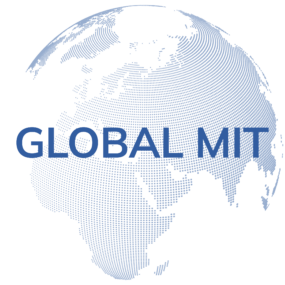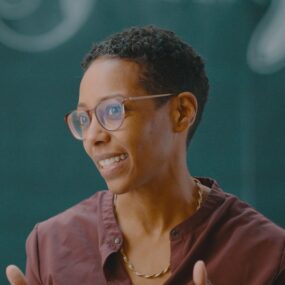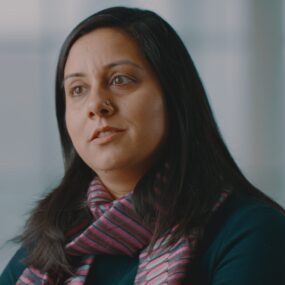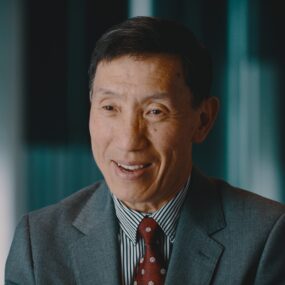Celebrating the Global Nature of MIT Faculty
For almost anyone anywhere familiar with higher education, MIT is a known and respected entity. Its reputation for leadership, innovation, and discovery is recognized around the globe. Perhaps less obvious – but equally remarkable – is how the world itself is represented across campus.
MIT’s 11,920 undergraduate and graduate students include nearly 3,500 who hail from outside the United States. Alumni come from 149 nations, and each year, more than 2,000 international scholars and researchers travel to MIT from nearly 100 countries to teach or further their research. And a stunning 47 percent of the MIT faculty are foreign born.
Truly, the world is at MIT.
“The World at MIT” videos underscore MIT’s distinctive nature as a community that is at once profoundly American and deeply connected to the world. In brief, three-minute interviews, faculty members recount how and why they came to adopt MIT as their professional home.
The video series, as described by Former Vice Provost for International Activities Richard Lester, “tells the personal stories of how a group of young people, growing up in vastly different parts of the world but united by a passion for learning, each found their way to MIT. And it reveals the extraordinary creativity that is ignited when individually brilliant faculty and students from around the world come together under the MIT dome to collaborate across intellectual disciplines and cultural backgrounds. The faculty featured in this series couldn’t be more diverse in terms of their birthplaces, their family circumstances, and the intellectual interests that drive them. Yet their stories resonate powerfully with one another – their intellectual curiosity, their purpose of service and their desire to make a positive difference in the world, and, most of all, the humility and humanity that shines through in every case.”

The World at MIT
Watch and hear highlights from interviews with the international faculty featured in “The World at MIT” video series.

Tayo Akinwande – Nigeria
Growing up in Nigeria, the son of educators, Tayo Akinwande quickly developed a love for his local library and clearly remembers reading about MIT in a Time-Life Series book on technology. Now a professor in MIT’s Electrical Engineering and Computer Science Department, he says he learns and gains new insights from his students in every class.

Daniela Rus – Romania
Fulfilling a school requirement by working in a locomotive factory one week each month, Daniela Rus learned to operate “machines that help us make things.” Appreciation for the practical side of math and science stuck with Daniela, who is now Director of the MIT Computer Science and Artificial Intelligence Laboratory (CSAIL), and the Andrew and Erna Viterbi Professor in the Department of Electrical Engineering and Computer Science.

Hashim Sarkis – Lebanon
Hashim Sarkis knew his calling early. He loved art and the way buildings looked and fit together and remembers that, even as a preschooler, he wanted to design them. Seeing photos of MIT’s “beautiful modernist buildings” in an architectural history textbook in Beirut was his first introduction to MIT, where he is now Dean of the School of Architecture and Planning.

Mai Hassan – Sudan
The experience of growing up in the Sudanese diaspora drew Mai Hassan to political science and a desire to examine topics related to authoritarianism, which she now does as an Associate Professor of Political Science at MIT. Knowing that some of her students will go on to influence the future of powerful new technologies such as artificial intelligence, Mai helps them understand the sometimes opaque connections between contentious politics and technology.

Moungi Bawendi – France/Tunisia
Moving from France to Tunisia to the United States as a child, Moungi Bawendi remembers he didn’t feel like he belonged anywhere. Much later, even his postdoctoral research on the properties of quantum dots again made him feel like an outsider entering “this field of synthetic chemistry that I really didn’t know much about.” An outsider in the field no more, Moungi is now at home as MIT’s Lester Wolfe Professor of Chemistry.

Nergis Mavalvala – Pakistan
Growing up in Pakistan, Nergis Mavalvala was aware of MIT’s “huge international brand…this place where the science and engineering and techy kids went.” A person who loves exploring “lofty questions” as well as the practical design of things, Nergis found a perfect fit at MIT and calls her position as the Marble Professor of Astrophysics and Dean of the School of Science “the best job in the world.”

Pattie Maes – Belgium
Coming of age in Belgium during the European economic crisis of the 1970s, Pattie Maes decided to pursue computer science for purely practical reasons – it was a field with jobs. She eventually realized, however, that she didn’t want a corporate position and so was drawn to MIT “because it was this mecca…where all this amazing research was happening.” She is now the Germeshausen Professor of Media Arts and Sciences at the MIT Media Lab and runs the Fluid Interfaces research group.

Paulo Lozano – Mexico
Paulo Lozano became fascinated with studying the cosmos as a child watching the changing night sky outside his home in Mexico, learning about NASA, and visiting a Mexico City planetarium with his parents. He now directs MIT’s Space Propulsion Lab and is the MIT-Mexico Program Faculty Director.

Roberto Rigobon – Venezuela
Deciding to remain in the US in the wake of political changes in his native Venezuela, Roberto Rigobon came to MIT to pursue a PhD and never left. The Society of Sloan Fellows Professor of Management and Professor of Applied Economics at the MIT Sloan School of Management, Roberto believes the diversity of disciplines and personal histories at MIT, “forces our ideas to become better.”

Sana Aiyar – India
Sana Aiyar grew up among adults who frequently discussed and debated history – a topic “contested deeply in India,” particularly in her native Delhi. An avid reader, she immersed herself in books to learn more about the world. Sana is now Associate Professor of History at MIT and Associate Faculty Member at the MIT-South Asia/India Program.

Yasheng Huang – China
Like many exchange students, Yasheng Huang intended to return and contribute to society in his native country after studying abroad. Following the Chinese government’s violent crackdown in Tiananmen Square in 1989, however, Yasheng decided to stay in the US and became increasingly interested in international issues and economics. He currently holds the Epoch Foundation Professorship of Global Economics and Management at the MIT Sloan School of Management and is Faculty Director of the MIT-China Program.
Extraordinary creativity is ignited when individually brilliant faculty and students from around the world come together under the MIT dome to collaborate across intellectual disciplines and cultural backgrounds.
Richard Lester, Former Vice Provost for International Activities
